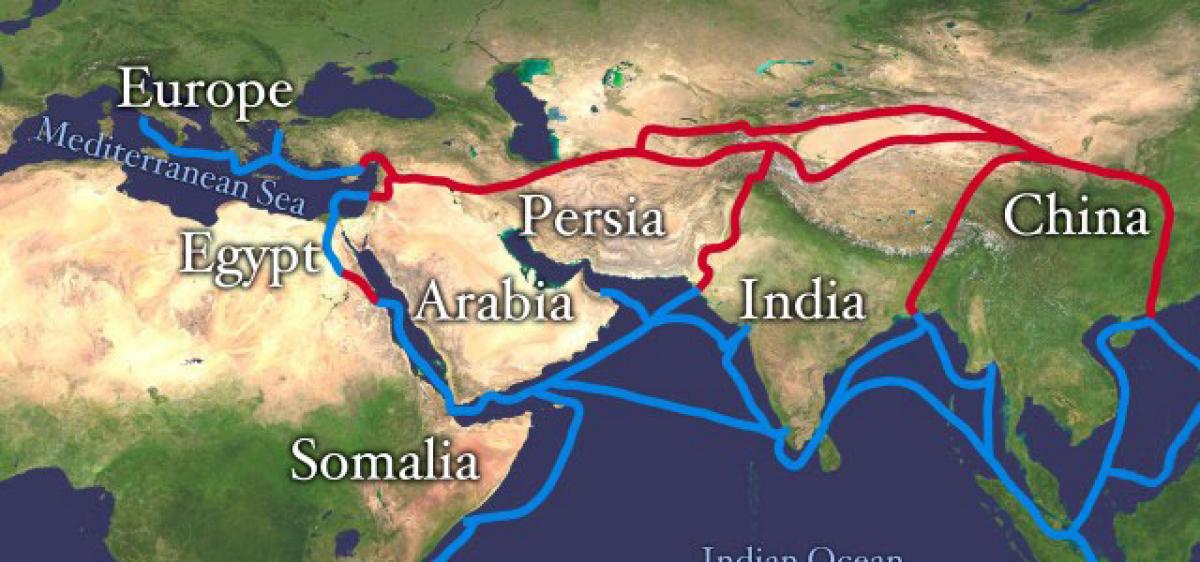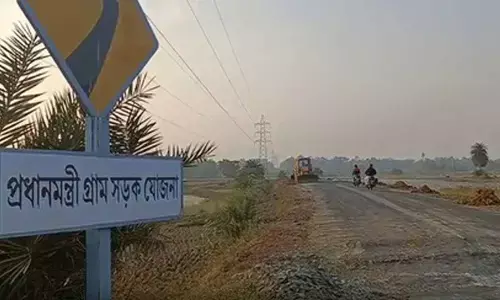China Belt and Road Initiative for international cooperation

Since 2013, the ‘One Belt, One Road’ (OBOR) initiative has become the centerpiece of China’s economic diplomacy. The essence of OBOR is to promote regional and cross-continental connectivity between China and Eurasia.
Since 2013, the ‘One Belt, One Road’ (OBOR) initiative has become the centerpiece of China’s economic diplomacy. The essence of OBOR is to promote regional and cross-continental connectivity between China and Eurasia.
It represents the first major attempt by China to design and implement a cross-continental mercantile strategy and will surely have significant global and geopolitical consequences.
- Recent UN support for China project passing through PoK puts India’s claim in jeopardy.
- In March 2017, a UNSC resolution was called on Afghanistan to tackle the “threats” posed by the Taliban, al-Qaeda, ISIS affiliates and other terrorist groups which threaten the security and stability of the war-torn country.
- The resolution adopted unanimously by the UN Security Council extended the mandate of UN Assistance Mission in Afghanistan until March 17, 2018, and expressed serious concern at the presence and potential growth of ISIS affiliates in the country.
- UNSC resolution welcomed current efforts to strengthen regional connectivity and economic cooperation between Afghanistan and its neighbours, citing the example of the Turkmenistan-Afghanistan-Pakistan-India (TAPI) gas pipeline project and the Chabahar port project between Afghanistan, India and Iran.
- However, the UNSC resolution had for the first time incorporated China’s Belt and Road Initiative (BRI), a multi-billion inter-continental connectivity mission that has a flagship project passing through Pakistan occupied Kashmir (PoK). It also said international efforts should be strengthened to implement the BRI.
- The UN endorsing the BRI could complicate the situation as far as India’s claims are concerned.
- India has a “sovereignty” issue with the BRI because its flagship project, the China-Pakistan Economic Corridor (CPEC), passes through PoK and according to diplomats, India endorsing the BRI would mean giving up its claims on PoK.
- Also included in the newly adopted council resolution was China’s Belt and Road Initiative, which aims to build a trade and infrastructure network connecting Asia with Europe and Africa along the ancient trade routes.
- After this, China promptly announced that this reference of Belt and Road Initiative (BRI) in UNSC resolution reflected a global consensus on the BRI. The Chinese envoy said that latest council move is conducive to creating a favourable atmosphere for China to host a Belt and Road forum for international cooperation in Beijing this May in order to brainstorm on interconnected development.
What is OBOR?
- The ‘One Belt’ and ‘One Road’ refer to China’s proposed ‘Silk Road EconomicBelt’ and ‘Maritime Silk Road’.
- Connectivity covers five major areas of interest: policy coordination, infrastructure construction (including railways and highways), unimpeded trade, financial integration and people-to-people ties. Among these, infrastructure construction is the dominant feature of the New Silk Road.
The Silk Road Fund:
- The US$40 billion Silk Road Fund has been established to finance the Belt and Road Initiative.
- It will invest mainly in infrastructure and resources, as well as in industrial and financial cooperation.
- The Fund was set up as a limited liability company in December 2014 with its founding shareholders including China’s State Administration of Foreign Exchange, the China Investment Corp, the Export-Import Bank of China and the China Development Bank.
- The Fund will comply with market rules and the international order of finance, and welcome participation from domestic and overseas investors, such as the China-Africa Development Fund and the Asian Infrastructure Investment Bank.
BRI: the grand design
- The BRI originated in 2013 when China’s President Xi Jinping in his speech outlined plans for China’s global outreach through connectivity and infrastructure development.
- The Silk Road Economic Belt includes land corridors from China through Central Asia and Russia to Europe with spurs to West Asia and to Pakistan — the China-Pakistan Economic Corridor (CPEC).
- The 21st century Maritime Silk Road links China’s east coast through major sea lanes to Europe in the west and the Pacific in the east.
- Together, they constitute the BRI (originally “One Belt One Road”, until the Chinese recently changed the name).
- The concept was subsequently fleshed out with multiple justifications and project ideas, finally giving it wings as the grand strategic vision of President Xi.
Objectives of BRI
Among Chinese objectives of the BRI are –
- finding outlets for excess capacity of its manufacturing and construction industries;
- increasing economic activity in its relatively underdeveloped western region; and
- creating alternative energy supply routes to the choke points of the Straits of Hormuz and Malacca, through which almost all of China’s maritime oil imports pass
- Through BRI, China can strengthen its influence over swathes of Asia and Africa, buttressing its ambitions to be a maritime power, and developing financing structures parallel to (and eventually competing with) the Bretton Woods system.
- It is a rich mix of economic, developmental, strategic and geopolitical motives. It is also the most ambitious global infrastructure project ever envisaged by one country.
Which countries are involved?
- The ‘Belt’ and ‘Road’ covers primarily Asia and Europe, encompassing around 60 countries.
- On China’s “One Belt, One Road” official website, it also says the initiative is open to all countries as well as international and regional organisations for cooperation.
Why is BRI important for China?
- China is obviously going to benefit from the “Belt and Road Initiative,” but what is unclear is to what extent. Critics said that Beijing is going for a bigger role as a global superpower. With this in mind, having a direct link to major countries may not only boost its economic power, but also its political clout in both the Western and Eastern hemisphere.
- Also, many of China’s production sectors have been facing overcapacity since 2006. The Chinese leadership hopes to solve the problem of overproduction by exploring new markets in neighbouring countries through OBOR. The OBOR initiative will provide more opportunities for the development of China’s less developed border regions.
- China also intends to explore new investment options that preserve and increase the value of the capital accumulated in the last few decades. OBOR has the potential to grow into a model for an alternative rule-maker of international politics and could serve as a vehicle for creating a new global economic and political order.
- China has cash and deposits in Renminbi equivalent to USD 21 trillion, or two times its GDP, and expects that the massive overseas investment in the BRI will speed-up the internationalization of the Renminbi.
- BRI is also seen as a strategic response to the military ‘re-balancing’ of the United States to Asia.
- China can also benefit from the New Silk Road project through other means like the easing up of growth of state-owned enterprises as well as an increase in the Chinese people’s income.
Benefits for ASEAN:
- Many ASEAN countries are rich in resources but lacking in construction funding which slows their economic growth, causing an infrastructure deficit and resulting in a low level of industrial development. The OBOR Initiative is probably a direct response to the ASEAN countries’ cry for help.
Challenges that confront the BRI:
- First, the perception, process and implementation to date do not inspire trust in OBOR as a participatory and collaborative venture. The unilateral ideation and declaration — and the simultaneous lack of transparency — further weaken any sincerity towards an Asian entity and economic unity. However, China says that it is committed to pursue wide-ranging consultations with the 60-plus nations on this issue.
- It is widely accepted that through this initiative China is projecting its military and political presence along OBOR. China is also willing to underwrite security through a collaborative framework. Hence, few countries including India have wholeheartedly not welcomed this initiative.
- Another challenge deals with the success of the ‘whole’ scheme, given that the Chinese vision document lays out five layers of connectivity: policy, physical, economic, financial and human. While no developing country will turn away infrastructure development opportunities financed by the Chinese, they may not necessarily welcome a rules regime built on a Chinese ethos.
- This belt runs through Pakistan-occupied Kashmir. Hence, a formal nod to the project will serve as a de-facto legitimisation to Pakistan’s rights on Pakistan-occupied Kashmir and Gilgit-Baltistan under the China-Pakistan Economic Corridor (CPEC) that is closely related to OBOR.
Concerns:
- Connectivity and infrastructure development are unexceptionable objectives. Much of Asia lacks them and the finances required to develop them.
However, analysts have highlighted a number of potential issues:
- Chinese overcapacity may override host countries’ development priorities in project selection;
- political tensions between countries may prevail over considerations of economic benefit;
- local elites may corner the “spoils” from new projects, thereby exacerbating social tensions; and
- Financing strategies may result in countries sleepwalking into a debt trap (the Hambantota development projects in Sri Lanka provide a telling example).
- Much will depend on how sensitive China is to international and local concerns on these counts. However, even if only a part of the grand BRI design is eventually implemented, it could have a major political and economic impact.
How is China countering these challenges?
- It has been inviting governments to organize summits to identify issues and seek common understandings, cooperation memorandum and people-to–people contact as the basis for regional cooperation.
- China is also organizing technical workshops of the concerned countries to facilitate investments and is partnering with multilateral institutions in this effort to give greater legitimacy. It is entering into areas the United Nations and bilaterals have ignored but have been considered important by developing countries.
- China is also using money to resolve security issues, like paying Pakistan for an army division dedicated to the protection of Gwadar and is actively considering setting up a private security agency, borrowing ideas from something the United States has done for decades, but paid for by the companies rather than the government.
Is OBOR a threat or an opportunity for India?
- The answer undoubtedly ticks both boxes. Chinese political expansion and economic ambitions, packaged as OBOR, are two sides of the same coin. To be firm while responding to one facet, while making use of the opportunities that become available from the other, will largely depend on the institutional agency and strategic imagination India is able to bring to the table.
India’s stand on BRI and mid-May summit:
- Officially, India says it cannot endorse the BRI in its present form and has a “sovereignty” issue, since BRI includes the CPEC, which runs through Indian territory under illegal Pakistani occupation (Gilgit-Baltistan).
- Some analysts have argued for the more “pragmatic” approach of a partial endorsement: as the initiative rolls out in various countries, India can engage with them (and with China) to promote projects that would be of benefit.
- The mid-May (BRF) summit is said to include leaders of Russia, Turkey, Pakistan, Sri Lanka, Myanmar and Indonesia.
- The US, Germany, France and the U.K. will not be represented at the top level (because of their leaders’ domestic preoccupations).
- There are only two each from South Asia, Central Asia and Africa and none from West Asia. India has apparently not yet conveyed the level of its attendance.
- China has argued that India would be “isolating” itself by staying out and argues that connectivity provided by the BRI would enhance economic cooperation and promote peace
- This corridor would intersect the CPEC and may therefore open new routes for Chinese goods to both India and Afghanistan, besides promoting India, Pakistan and Afghanistan trade.
- With its investment in the CPEC now estimated at over $60 billion, its increasing bilateral assistance to Pakistan and its growing military presence in that country, China is in a strong position to persuade Pakistan to recognise that this is in its best economic interest: it may even transform the CPEC into a commercially viable project.
- Project Mausam: It is soft power diplomacy by India. The project is under Ministry of Culture and its purpose is to reconnect and re-establish communication links between countries of Indian Ocean and enhancing their cultural values.
- SagarMala: It is a port led direct and indirect development with a focus on infrastructure and connectivity. The project is to enhance the capacity of major and non-major ports and also to start their modernization process.
- Chabahar Port: Chabahar’s location give India access, besides Iran, to Afghanistan, central Asia, and Europe, bypassing Pakistan altogether and cutting down significantly current travel distances and time. International North South Transport Corridor initiated by India, Russia, and Iran is another connectivity solution for India in Central Asia.
- Naval Ports: India is developing naval ports in Indian Ocean regions like at Madagascar, Seychelles, and Mauritius.
- IORARC: India is involved in the Indian Ocean Rim Association grouping whose first summit took place in Jakarta in 2017.
- Alliances: Alliance of India with like-minded countries like Japan. Japan has agreed to promote India’s “Act East” policy by developing and strengthening reliable, sustainable and resilient infra that augments connectivity within India and between India and other countries in the region aimed at advancing Asian industrial networks and regional value chains with open, fair and transparent business environment in the region. Japan and India can build rail and road connectivity across the Eurasian landmass running parallel to OBOR.
Advantages of joining BRI
- India will not be able to stop China in carrying on this initiative nor can it stop its neighbours from joining this initiative. So whether India joins this initiative or not, the project will take place and not join may harm India’s interests.
- India may become isolated in this region since all of its neighbours (except Bhutan) have joined One Belt One Road. Leaving any regional platform may hamper India’s credentials and may hasten the end of its regional hegemony.
- Some analysts say that this initiative will be a win-win situation for India since it will increase the connectivity of the region. There may emerge mutually beneficial swap where India protecting Chinese interests in the Indian Ocean and China securing India’s essential undertakings in their part of the waters.
- Regional transport, energy security, and blue economy are key to BRI initiative which will be helpful for India.
- China has the financial capital, technology to accelerate the development of other countries and India also need resources and funds for its own development.
- Trade: The BRI project will open more links of trade between India and other countries. Further, India does not enjoy much leverage to guide ocean trade markets despite having proximity to the sea and a strong navy. Through OBOR project India will get access to more business in an environment which promote friendly reforms.
- Some analysts feel that countries like Russia and others in SCO would want Indian participation in BRI as a counterweight to Chinese influence.
- Regardless of economic interests, India cannot ignore the symbolic significance as it was along the Silk Route that Indian trade and philosophy (Buddhism) traveled to the rest of Asia. Thus China may gain cultural hegemony in the region which may prove counter-productive to India.
Disadvantages of joining BRI
- BRI is a unilateral ideational of China and there is a lack of transparency in its working. The process is not participatory and collaborative in nature.
- Under Maritime Silk Route (MSR) China is developing ports in Bangladesh, Sri Lanka, and Pakistan and is trying to enlarge its influence using its economic might in the Bay of Bengal and the Arabian Sea. Thus MSR is nothing but an economic disguise to the “Strings of Pearls” Theory. China is investing a huge amount of money in India’s immediate neighbourhood and these countries tend to use the China card against India.
- BRI seems to be primarily driven by broad geostrategic and geopolitical aim. For Example, China-Pakistan Economic Corridor gives de facto legitimization to Pakistan’s rights in Pakistan Occupied Kashmir which is against India’s interests.
- Since this port is closer to the Persian Gulf, it could be used as a trans-shipment point for China’s energy supplies obviating the needs to go through the Strait of Malacca in South East Asia. Apart from serving as a commercial port, Gwadar is also deep enough to accommodate submarines and aircraft carriers. Thus it may be used as a military port by People Liberation Army Navy in future.
- Through OBOR, China is countering the strategies of India in North East region and is promoting its greater presence in North East India, part of which China claims as its own territory. This may have a security impact on Indi
What’s next?
- Will India participate in the BRF summit? Will India ask China whether it is willing to address its concerns in such a way as to enable high-level Indian participation?
- Would China be willing to declare that the CPEC is not a component of the BRI but a separate bilateral China-Pakistan project?
- Will BRF provide New Delhi the opportunity to extract something of commensurate value in return?
Way ahead for India:
- India now needs to match ambition with commensurate augmentation of its capacities that allows it to be a net security provider in the Indian Ocean region.
- This will require the government to not only overcome its chronic inability to take speedy decisions with respect to defence partnerships and procurement, but will also necessitate a sustained period of predictable economic growth; BRI can assist in the latter.
- Chinese railways, highways, ports and other capacities can serve as catalysts and platforms for sustained Indian double-digit growth.
- Simultaneously, India can focus on developing last-mile connectivity in its own backyard linking to the BRI — the slip roads to the highways, the sidetracks to the Iron Silk Roads.
- Currently, India has neither the resources nor the political and economic weight to put in place competitive and alternative connectivity networks on a global scale.
- Therefore, for the time being, it may be worthwhile to carefully evaluate those components of the BRI which may, in fact, improve India’s own connectivity to major markets and resource supplies and become participants in them just as we have chosen to do with the AIIB and the NDB.















